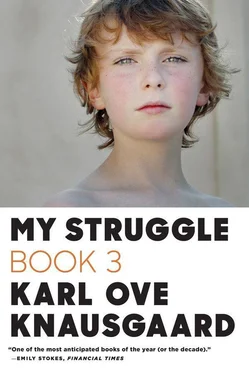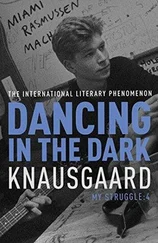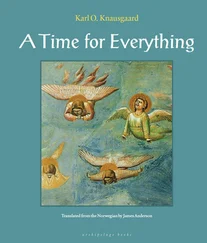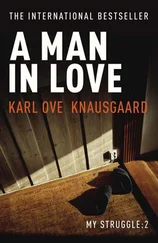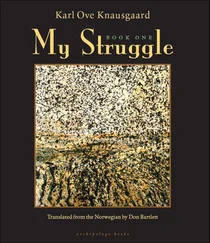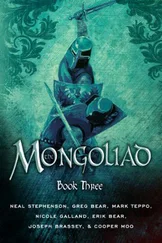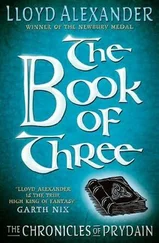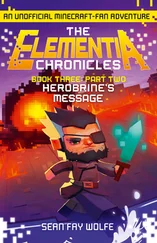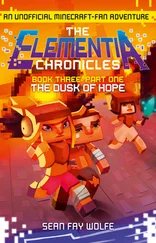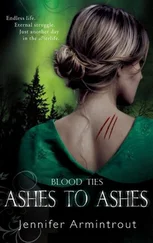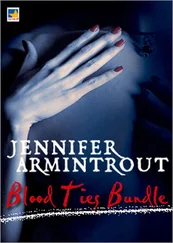And then there were the men working on the drainage. The ones who parked their cars by one of the many manhole covers in the road, which were either set in the tarmac or placed on top of a brick circle somewhere close by, and who, after putting on rubber boots reaching up to their waists ! levered up the round, enormously heavy, metal lid with a crowbar, shifted it to the side and climbed down. We watched as first their calves disappeared from view, into the hole under the road, next their thighs, then their stomachs, then their chests and finally their heads … And what was there beneath if not a tunnel? Where water flowed? Where you could walk? Oh, this was just great. Perhaps one of them was over there now, beside Kent Arne’s bike, which was lying strewn across the sidewalk, about twenty meters away, except that he was under the ground! Or were these manholes kinds of stations, like wells, where you could inspect the pipes and draw water when there was a fire? No one knew; we were always told to keep well away when they climbed down. No one dared ask them. No one was strong enough to lift off the heavy, coin-shaped metal covers on his own. So it remained a mystery, like so much else in those years.
Even before we started school we were free to roam wherever we wanted, with two exceptions. One was the main road, which ran from Tromøya Bridge to the Fina station. The other was the lake. Never go down to the lake on your own! the adults instilled in us. But, actually, why not? Did they think we would fall into the water? No, that wasn’t it, someone said when we were sitting on the rocks beyond the little meadow where we sometimes played soccer and looking down over the edge of the steep cliff into the water, perhaps thirty meters beneath us. It was the water sprite. It abducted children.
“Who says so?”
“Mom and Dad.”
“Is it here ?”
“Yes.”
We gazed down at the grayish surface of the water in Ubekilen. It didn’t seem improbable that there was something lurking beneath.
“Only here?” someone asked. “If so, we can go somewhere else. Lake Tjenna?”
“Or Little Hawaii?”
“There are other sprites there. They’re dangerous. It’s true. Mom and Dad told me. They kidnap children and drown them.”
“Could it come up here?”
“Dunno. No, I don’t reckon so. No. It’s too far. It’s only dangerous by the water’s edge.”
I was scared of the sprite after that, but not as scared as I was of foxes, the thought of them terrified me, and if I saw a bush stir or I heard something rustle past, then I was off, running to safety, to an opening in the forest, that is, or up to the estate, where the foxes never ventured. In fact, I was so frightened of foxes that Yngve only had to say, I am a fox, and I am coming to get you — he was in the upper bunk and I was in the lower one — and I froze in terror. No, you aren’t, I would say. Yes, I am, he would say, hanging over the edge and hitting out at me. Despite this and even though he did frighten me now and then, I missed having him there when we each had our own room and suddenly I had to sleep alone. It was all right, after all, it was inside the house, the new room, but it wasn’t as good as having him there, in the bunk above me. Then I could just ask him things, such as, “Yngve, are you frightened now?” and he might answer “No-oo, why should I be? There’s nothing to be frightened of here.” And I would know he was right and feel reassured.
The fear of foxes must have worn off when I was about seven. The vacuum it left, however, was soon filled by other fears. One morning I was walking past the TV, it was on although no one was watching, there was a matinee film, and there, oh no, oh no, there was a man with no head walking up a staircase! Aaagh! I ran into my room, but that didn’t help, I was just as alone and defenseless there, so off I went in search of Mom, if she was at home, or Yngve. The image of the headless man pursued me, and not just in the night, which the other fearful visions I had did. No, the headless man could appear in broad daylight, and if I was alone it made no difference that the sun was shining or the birds were singing, my heart pounded and fear spread like fire to every tiniest nerve ending in my body. It upset me more that this darkness could also appear in the daylight. In fact, if there was one thing I was really frightened of, it was this darkness in the light. And the worst of it was that there was nothing I could do about it. Shouting for someone didn’t help, standing in the middle of an open area didn’t help, and running away didn’t help. Then there was the front cover of a crime magazine that Dad once showed me, a comic he’d had when he was a child, showing a skeleton carrying a man over its back, and the skeleton had turned its head and was looking straight at me through its hollow eye sockets. I was afraid of that skeleton as well; it too appeared in all sorts of expected and unexpected contexts. I was also afraid of the hot water in the bathroom. Because whenever you turned on the hot tap a shrill scream traveled through the pipes, and immediately afterward, if you didn’t turn it off at once, they started banging. These noises, which were one unholy racket, scared the wits out of me. There was a way of avoiding them, you had to turn on the cold water first, and then somehow fiddle with the hot tap until the temperature was right. That was what Mom, Dad, and Yngve did. I had tried, but the shrill scream that penetrated the walls and was followed by a crescendo of banging, as though something down below was working itself up into a fury, started the second I touched the hot-water tap, and I turned it off as fast as I could, and ran out, my body shaking violently with fear. So, in the morning, I either washed in cold water or took Yngve’s dirty but lukewarm water.
Dogs, foxes, and plumbing were concrete, physical threats, I knew where I was with them, either they were there or they weren’t. But the headless man and the grinning skeleton, they belonged to the kingdom of death, and they couldn’t be handled in the same way, they could be anywhere and everywhere, in a cupboard if you opened it in the dark, on the stairs as you were going up or down, in the forest, indeed even under the bed or in the bathroom. I associated my own reflection in windows with the creatures from beyond, perhaps because they only appeared when it was dark outside, but it was a terrible thought, seeing your own reflection in the black windowpane and thinking, that image is not me, but a ghoul staring in at me.
The year we started school none of us believed in sprites, pixies, or trolls anymore, we laughed at those who did, but the notion of ghosts and apparitions persisted, perhaps because we didn’t dare ignore it; dead people did exist, and we knew that, all of us. Other notions we had, coming from the same tangled realm, that of mythology, were of a happier, more innocent nature, such as that of the pot of gold at the end of a rainbow. Even that autumn when we started the first class we still believed the myth enough for us to go in search of the rainbow. It must have been one Saturday in September, the rain had been pouring down all morning, we were playing on the road below the house where Geir Håkon lived, or, to be more precise, in the ditch that was flooded with water. At this exact spot the road passed a blasted rock face, and water was dripping and trickling down from its moss, grass, and soil-covered top. We were wearing rubber boots and thick, brightly colored oilskin trousers and jackets, with the hoods tied around our chins, thus displacing all sound; your own breathing and the movements of your head, where your ears met the inside of the hood, were always loud and clear while everything else was muffled and seemed to be happening a long distance away. Between the trees on the other side of the road and at the top of the mountain above us the mist was thick. The orange rooftops on both sides of the road downhill wore a dull sheen in the gray light. Above the forest at the bottom of the slope the sky hung like a swollen belly, penetrated by the pouring rain, which continued to dance on our hoods and now oversensitive ears.
Читать дальше
